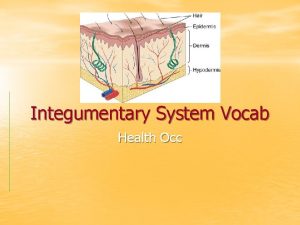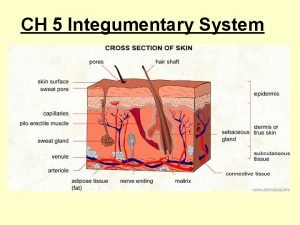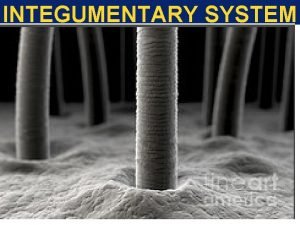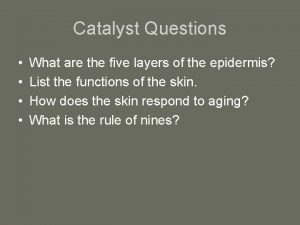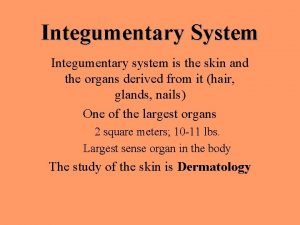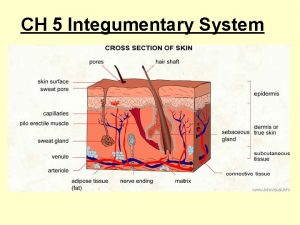or the Integumentary System Human Skin Facts Skin

















- Slides: 17

or the Integumentary System

Human Skin Facts • Skin is the largest organ of the body. • The skin has a surface area of 1 to 2 square meters and weighs 4 to 5 kilograms

Human Skin Facts • You have approximately 19, 000 skin cells on every square inch of your body. • We keep renewing our skin our entire lives.


The Integumentary System is made up of…. . • Skin • Sweat Glands • Oil Glands • Hair • Nails Main Function = Protection

The skin varies in thickness from 1. 5 to 4. 0 mm and has 2 distinct regions…. • Epidermis – composed of epithelial cells, it is the outermost protective shield • Dermis – the underlying layer composed of fibrous connective tissue, it is tough and leathery

Epidermis • It is a keratinized stratified squamous epithelium –the deep layers of the epidermis undergo constant mitosis and the bottom layer cells are pushed toward the surface. • Keratin is the fibrous protein that gives the epidermis its protective quality


Dermis • The dermis binds the body together like a body stocking (our hide) • It is richly supplied with nerve fibers, blood vessels, and lymphatic vessels • Hair follicles, oil glands and sweat glands reside in the dermis.

What Contributes to Skin Color? • Melanin – a pigment that ranges in color from yellow to reddish-brown to black • Carotene – a yellow to orange pigment • Hemoglobin – pinkish hue of fair skin caused be oxygenated hemoglobin in red blood cells

Homeostatic Imbalance • Cyanosis – skin appears blue because of lack of oxygen • Erythema (redness) – fever, hypertension, inflammation, embarrassment • Pallor or blanching – anemia, low blood pressure, fear, or emotional stress

• Jaundice – yellow cast due to liver disorder • Bronzing – metallic appearance due to Addisons disease (hypofunction of adrenal cortex) • Bruises or hematomas – clotted blood under the skin

Sweat Glands • 2. 5 million person Sweat is a filtrate of the blood made up of 99% water, salts, vitamin C, antibodies, dermicidin (a microbe killer), urea, uric acid, ammonia, lactic acid, any ingested drugs Sweat is usually acidic - p. H 4 -6

Sebaceous (Oil) Glands • Secrete sebum (an oily secretion) • Sebum lubricates hair and skin, slows water loss from skin, and has a bactericidal action Blocked sebaceous glands form whiteheads, if the blocking material dries it is called a blackhead

Nails -Scalelike modifications of epidermis containing hard keratin

Hair • Hair follicles make flexible strands consisting of dead cells made of hard keratin

Hair Variations……. Kinky hair – a cs. of the shaft is flat Wavy hair - a cs. of the shaft is oval Straight hair - a cs. of the shaft is round • Hair color is created by melanin from the base of the hair follicle
 The integumentary system facts
The integumentary system facts Intugementary
Intugementary Glands in integumentary system
Glands in integumentary system Integumentary system vocabulary
Integumentary system vocabulary Integumentary system fetal pig
Integumentary system fetal pig Integument adalah
Integument adalah Exercise 7 the integumentary system
Exercise 7 the integumentary system Integumentary system vocab
Integumentary system vocab Integumentary system medical terminology
Integumentary system medical terminology Integumentary system
Integumentary system Integumentary system physical examination
Integumentary system physical examination Excretory system analogy
Excretory system analogy Cat integumentary system
Cat integumentary system The integumentary system
The integumentary system Integumentary system components
Integumentary system components Effects of aging on the integumentary system
Effects of aging on the integumentary system Section 36-3 the integumentary system
Section 36-3 the integumentary system Integumentary system
Integumentary system







